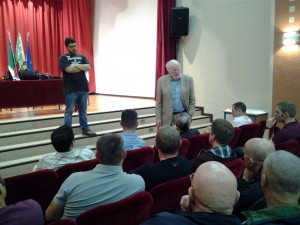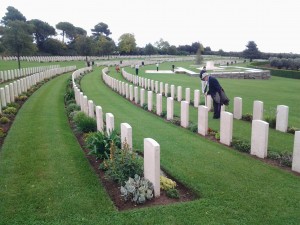Battlefield Study of The Parachute Regiment. The 4 PARA on the Gustav Line, 1943 – 1944
A research project I carried out on ‘The Red Devils in the Italian Campaign’, commisioned by The Parachute Regiment (British Army), prompted the first regimental battlefield study visit by the Parachute Regiment to historic sites on the Gustav Line in Italy. The visit by members of the 4th Battalion Parachute Regiment was led by Lt Col Giles Matthew Timms MC, who has recently served in Afghanistan, and Maj Richard Hargreaves MC (OC B Coy, 4 PARA), aged 95, a veteran of the Second World War who fought in the area of the Aventino River and on the slopes of the Maiella massif in the Abruzzo region 71 years ago.
It was an honour to be able to tell the British paras about this untold, and yet important chapter of their regimental history, a chapter which has been almost entirely neglected for over seventy years. At the same time, we were able to examine the surprising similarities between operations in this area of Italy and the more recent Operation Herrick in Afghanistan, both in terms of operational tactics and the difficulty of the terrain.
The battlefield study visit began on 23 October 2014 in Casoli, at the former primary school, where Lt Col Vic Coxen DSO MC (CO 4 PARA) established the first Allied headquarters in the area 71 years ago, on 6 December 1943. During the evening of 2 December 1943, 4 PARA (as part of the 2nd Independent Parachute Brigade) had been put under the command of the 2nd New Zealand Division, with the task of defending the Division’s left flank during the advance on Orsogna.
After an introduction to the historical background of the Italian campaign and the deployment of the 1st Airborne Division in Operation Slapstick, I accompanied the group of servicemen up the castle tower in Casoli, a vantage point from which we were able to survey the entire sector that was entrusted to the Red Devils. The front extended over 30 kilometres from the west of Casoli to the northeast. The German troops had selected the Sangro basin below the river bend at Alfedena as a natural bulwark in their defences, with support positioned on the northwestern side , in particular on the Maiella massif and on the hills sloping down towards the Adriatic Sea between the villages of Pennapiedimonte, Guardiagrele, Orsogna and Ortona. Perched on steep hills, these villages made for ideal defensive points, with their low stone buildings and narrow streets. The middle part of the Sangro River Valley and the entire course of the Aventino River were notoriously susceptible to landslides and erosion, and the area was also infamous for being subjected to heavy winter snowfall, with temperatures reaching as low as -11°C.
The initial plan was for the paras to secure all the small villages to the west of Casoli and to reconnoitre the main German artillery observation points between Pennapiedimonte and Guardiagrele. This gave the Red Devils a highly demanding task to perform, bearing in mind the nature of the terrain and the fact that the few roads available were entirely vulnerable to the direct and indirect fire of the German troops. As mountain guides, Lt Col Coxen decided to use the partisans of a newly formed resistance unit, the Gruppo Patrioti della Maiella [Group of Maiella Patriots], which had been founded in Casoli on 5 December 1943 by Ettore Troilo, a local lawyer. Although they had not at first been officially recognised by commanders of the Eighth Army, the partisans proved to be useful guides for the paratroopers, accompanying them along forest paths very close to enemy positions.
Following the same old paths, I accompanied the modern-day British paratroopers to the small village of Palombaro, where Lt Leslie John Deacon had arrived late on 6 December 1943, led by the partisans. The Mayor of Palombaro at the time spoke a little English, and he informed Leslie’s platoon of German patrols and observation posts in the area of Pennapiedimonte, a small village that had a key position on the Maiella front. Our journey then continued towards Balzolo, an area in the municipality of Pennapiedimonte where the German forces had set up an observation post in 1943, which is still visible today. This point gave the German troops an overview of the whole area of operations from Guardiagrele to Casoli and on to Orsogna. The partisans led Lt Deacon towards this point. At dawn on 8 December, the British paratroopers launched a frontal attack on the German positions, which were taken. As Major Hargreaves himself remembered, this was the first significant breach of the Gustav Line. From Pennapiedimonte, it would be possible to advance towards Guardiagrele, where the German troops were covering the deployment of defences in Orsogna. From his vantage point at Pennapiedimonte, Deacon sought to persuade the New Zealand command to move on Orsogna from Guardiagrele, following the tactics best suited to the terrain, but the New Zealanders opted for an open battle with armoured vehicles, suffering a heavy defeat.
The most important part of the study visit took place later that afternoon in the cinema auditorium, in the former primary school in Casoli. Through a Skype video connection, the British paras were able to speak with Maj Paddy Deacon MBE MC, who was decorated with the Military Cross for his actions at Pennapiedimonte and Guardiagrele, while still a lieutenant. An interesting debate followed between the two veterans and Lt Col Timms regarding the tactics adopted by British airborne forces on the Maiella front and in Afghanistan. Seventy years ago, platoon commanders did not have the cutting-edge communication systems or close air support of today when they went out on patrol. They were often forced to make quick decisions while moving through mountainous terrain covered in vegetation, where German ambushes were frequent occurrences, as was the possibility of running into fascist spies. Maj Hargreaves stressed the critical role of the local population in Abruzzo and their self-sacrifice in supplying the British paratroopers with provisions when they were often isolated on barren snow-covered mountains.
A fine example of the attacks carried out by platoons was the action led by Lt Pat Angier (9 Platoon, C Company) in the small village of Civitella Messer Raimondo, which was the next stop on the battlefield study trip. There, I was able to describe the attack on the garrison at Civitella, which allowed the British paratroopers to secure one of the most strategically important villages. The visit was made even more emotional by the eyewitness account of the partisan Michele Mancini, who took part in the action led by Lt Angier against the German paratroopers, when Mancini was aged only seventeen.
The subsequent event was held in the municipality of Civitella Messer Raimondo, where the Mayor, Danilo D’Orazio arranged the official celebration in memory of the Parachute Regiment. The Mayor took the stage immediately after and kindly tanked everyone for their attendance and reminded everyone present of the importance of the event. I was heartening to see the children from the local school attending at the event.
The proceedings at the main hall drew to a close with a series of presentations to Maj Richard Hargreaves MC and Lt. Col. Timms MC, representing the 4th Battalion The Parachute Regiment, who were presented with honorary citizenship of the Civitella Messer Raimondo from the Mayor.
We had planned a stop at La Morgia, a ridge near Gessopalena, but this had to be cancelled due to poor weather. La Morgia had been an important German defensive site with mortars and machine gun emplacements. For the entire time they were at the front line in this area, the paratroopers were continually tasked with taking this particular site, without any artillery support. The trenches dug there can still be seen, and signs of the furious fighting are still visible in the surrounding villages.
The last step of the battlefield study in Abruzzo ended in Ortona, where the lawyer and historian Andrea Di Marco led the paris through the main places of the Ortona Battle, an extremely fierce urban battle fought between a battalion of German paratroopers and assaulting Canadians forces.
After visiting Abruzzo, the battlefield study trip continued to the town of Cassino, in Lazio, known as the site of one of the bloodiest battles of the Second World War. With the support of Damiano Parravano, President of the Gustav Line Association, an educational and research organisation, the British paras visited the key position on Castle Hill, where they were able to gain a clear picture of the territory on which the battle was fought and of the German positions that dominated the Liri Valley and the town of Cassino. The 4th Battalion Parachute Regiment was deployed on 4 April 1944, occupying the railway station sector, where they lay at the mercy of the enemy positions on higher ground to the north. All their units experienced the constant smokescreens used to conceal unavoidable movements in daylight.
The visit ended at the Abbey of Monte Cassino, where an exhibition had been set up (thanks to the support of the Airborne Assault Museum and Archive of the Parachute Regiment & Airborne Forces) especially for the occasion, telling the story of the Red Devils at the Battle of Monte Cassino.
(Thanks are due to The Parachute Regiment , British Army, the Capt. Adam Sergeant (4 PARA), Dr Guy Puzey, the staff of the Airborne Assault Museum and Archive of the Parachute Regiment & Airborne Forces, Associzione Linea Gustav, Avv. Andrea Di Marco and the Municipalities of Casoli and Civitella Messer Raimondo for their excellent support).







